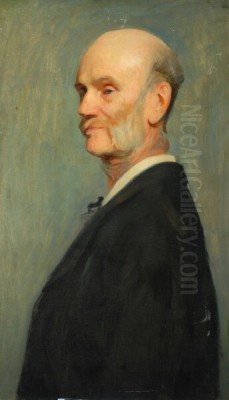
Hercules Brabazon Brabazon stands as a unique figure in the landscape of British art. Born into privilege and initially pursuing a path far removed from professional painting, he emerged late in life as a watercolourist of remarkable originality and sensitivity. Active primarily during the latter half of the 19th century and into the early 20th, his work, characterized by its vibrant colour and atmospheric suggestion, is often seen as a vital precursor to British Impressionism. His very name, changed mid-life upon inheriting family estates, hints at a life less ordinary, one dedicated ultimately to the pursuit of art and beauty across continents.
Early Life, Education, and a Change of Name
Hercules Brabazon Sharpe was born in Paris on November 27, 1821, the son of Hercules Sharpe and Anne Mary Sharpe. His upbringing was that of a gentleman of means, including education at the prestigious Harrow School. Following Harrow, he attended Trinity College, Cambridge, where, perhaps surprisingly given his later artistic inclinations, he pursued mathematics, earning his Bachelor of Arts degree in 1844 and a Master of Arts in 1848.
Despite his academic achievements in mathematics and his family's potential expectations – his father reportedly wished him to study law – the young Sharpe felt a stronger pull towards the arts. Rejecting a conventional career path, he made the pivotal decision to leave England and travel to Rome. In the Eternal City, he immersed himself not only in painting but also in music, indicating a broad artistic sensibility from an early stage.
A significant turning point occurred in 1847 when he inherited the family estates of his maternal uncle, Sir William Brabazon, in Connaught, Ireland. A further inheritance followed in 1858 with the Brabazon estates in Sussex. It was upon inheriting the first of these properties that he formally changed his surname, adopting the distinctive double name by which he is known in art history: Hercules Brabazon Brabazon. This inheritance provided him with financial independence, freeing him entirely to dedicate his life to his twin passions: art and travel.
The Path to Artistic Mastery
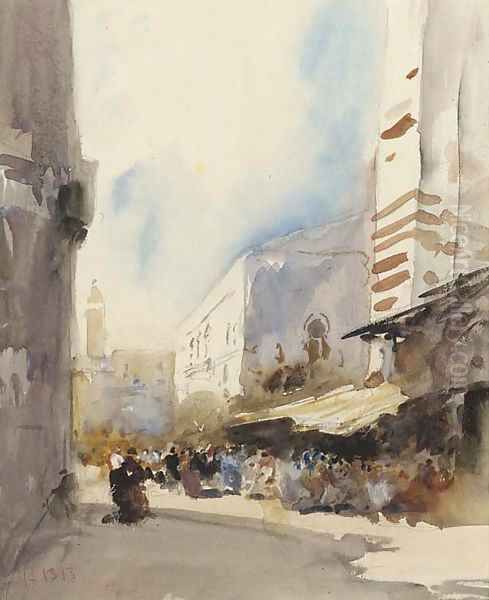
Freed from financial constraints and conventional career pressures, Brabazon embarked on a life devoted to artistic development and exploration. While largely considered self-taught, his time in Rome and subsequent travels were crucial periods of learning and absorption. He didn't attend formal art academies in the traditional sense but studied the works of masters firsthand, particularly during his time in Italy and Spain.
His artistic sensibilities were profoundly shaped by certain key figures. He held the Spanish Baroque master Diego Velázquez in high esteem, drawn perhaps to his mastery of tone and composition. Even more significant was the influence of the great British Romantic painter, J.M.W. Turner. Turner's revolutionary approach to light, colour, and atmosphere, especially in his later watercolours, resonated deeply with Brabazon and left an indelible mark on his own developing style.
Brabazon also absorbed lessons from the earlier generation of English watercolourists. His work shows an affinity with the freshness and directness found in the landscapes of David Cox and Peter De Wint, artists who excelled at capturing the nuances of the British countryside. The technical skill and sometimes the richer palette of William Mulready might also be seen as part of the artistic milieu he inherited, even if Brabazon's own path would lead towards a more explicitly impressionistic rendering of light and colour. He was known, according to some accounts, for his skill in imitating the styles of others, a practice common for artists honing their craft.
A Lifetime of Travel and Painting
Inheritance provided Brabazon not just with the time but also the means to travel extensively, and travel became the wellspring of his art. For decades, he moved across Europe, Africa, and Asia, sketching and painting constantly, capturing the essence of the places he visited. His journeys were not mere holidays; they were artistic pilgrimages that fueled his creative output.
His European itineraries were comprehensive. He spent considerable time in Italy, with Venice becoming a particularly favoured subject, its unique interplay of light, water, and architecture offering endless inspiration. France, Switzerland, and Spain were also frequent destinations, each landscape providing different challenges and opportunities for his brush. His Spanish travels allowed him further engagement with the works of Velázquez and other Spanish masters.
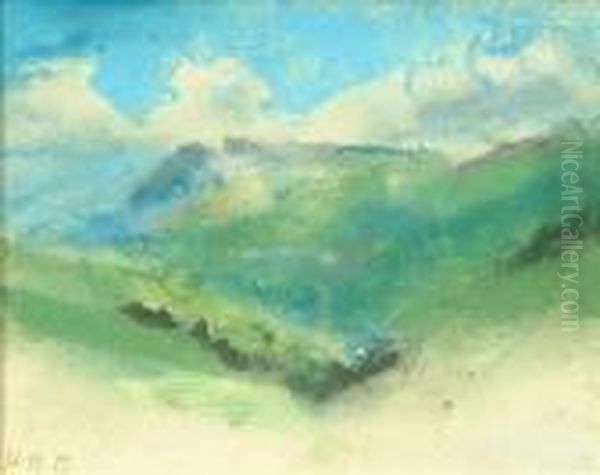
Beyond Europe, Brabazon ventured further afield than many artists of his time. He traveled to Egypt, capturing the distinct light and ancient monuments of the Nile Valley. His journeys also took him to India and the Middle East, broadening his palette and subject matter to include bustling street scenes, exotic architecture, and the intense colours of sun-drenched landscapes. These travels imbued his work with a cosmopolitan flavour and a remarkable diversity of place. Landscape and architectural views remained his primary focus throughout these extensive travels.
Artistic Style: Colour, Light, and Impression
Hercules Brabazon Brabazon's mature artistic style is most notable for its brilliant handling of colour and its suggestive, atmospheric quality. Working almost exclusively in watercolour, often enhanced with bodycolour or gouache, he developed a technique that prioritized capturing the immediate sensation of a scene – the fleeting effects of light and colour – over precise topographical detail.
His use of colour was bold and often unconventional for its time. He employed pure, luminous hues, juxtaposing them in ways that created vibrancy and harmony. His palette could range from delicate pastel shades, capturing the soft light of dawn or dusk, to intense, saturated colours reflecting the brilliance of Mediterranean or Eastern sunlight. This emphasis on colour as the primary means of expression aligns him strongly with the burgeoning Impressionist movement, although his development was largely independent.
Brabazon's technique involved fluid washes, expressive brushwork, and a willingness to leave areas of the paper untouched or minimally worked, allowing the white of the paper to contribute to the overall effect of light and air. His compositions, while seemingly spontaneous, demonstrate a sophisticated understanding of balance and design. Often, his sketches possess an abstract quality, where form dissolves into patterns of light and colour, anticipating later developments in modern art. He was a master of suggestion, evoking mood and atmosphere with remarkable economy of means.
This distinctive approach earned him high praise, albeit late in his career. The influential critic John Ruskin, a champion of Turner, reportedly declared Brabazon to be "the only person since Turner who could paint." While perhaps hyperbolic, this statement underscores the perceived quality and originality of Brabazon's work within the lineage of British watercolour painting. His art possesses a freshness and immediacy that feels remarkably modern.
Representative Works and Diverse Subjects
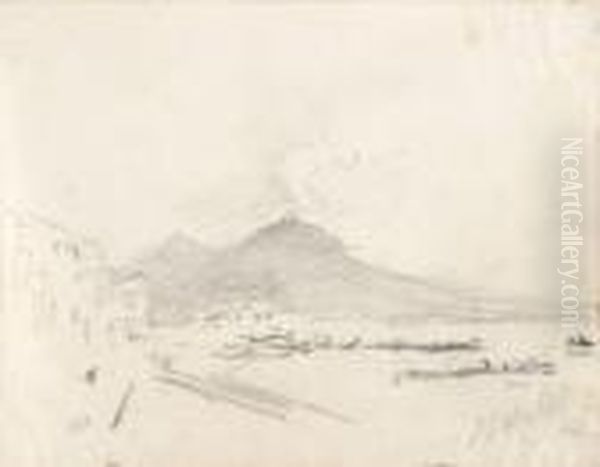
While Brabazon produced thousands of sketches and watercolours throughout his long life, certain works and subjects stand out. His depictions of Venice are among his most celebrated. Works like Venice - View towards San Giorgio (titles vary) capture the shimmering light on the lagoon, the distinctive silhouettes of buildings, and the movement of gondolas with fluid grace and evocative colour. These Venetian scenes perfectly suited his interest in light, reflection, and atmosphere.
Another notable work, A Vase of Violets, showcases a different facet of his talent. This still life demonstrates his exquisite colour sense, combining rich purples and greens. Some descriptions note a blend of influences, perhaps hinting at Japanese aesthetics in its composition or Greek elements in its decorative feel, highlighting his eclectic visual interests. It reveals his ability to find beauty in intimate subjects as well as grand landscapes.
His Palazzo Rezzonico at Night is a prime example of his impressionistic approach applied to an architectural subject under specific lighting conditions. The work likely emphasizes mood, shadow, and the play of artificial light on the grand facade, showcasing his skill in composition and achieving a harmonious balance of colour and tone even in low light.
Travels further afield yielded works like Street Scene in Cairo, depicting the verticality of buildings contrasted with palm trees under an African sky. This subject allowed him to explore the unique light and architectural forms of Egypt. Other recorded titles give a sense of his range: Du Maurier and Lamont (suggesting figure studies or portraits), The Highlands (Scottish landscapes), Donner Seamouth (likely a coastal or seascape), Furió, Ischia (Italian coastal views), and Vesuvius (the iconic Italian volcano). These titles confirm his focus on landscape, architecture, and occasionally figures, drawn from his extensive travels.
Late Recognition and Enduring Influence
Despite painting prolifically for decades, Hercules Brabazon Brabazon was essentially an amateur in the sense that he did not need to sell his work to live, and he rarely exhibited publicly until late in life. For years, his art was primarily shared with friends and fellow connoisseurs. His public "debut" came remarkably late, when he was over seventy years old.
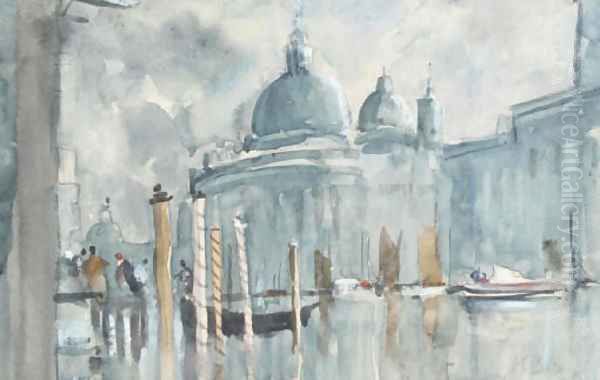
This belated recognition was largely thanks to the encouragement and advocacy of fellow artists, most notably the celebrated portrait painter John Singer Sargent. Sargent, who greatly admired Brabazon's work, persuaded him to exhibit. In 1891 or 1892, Brabazon showed works with the progressive New English Art Club (NEAC), an organization founded in opposition to the perceived conservatism of the Royal Academy. He subsequently held a successful solo exhibition at the Goupil Gallery on Bond Street, London, which firmly established his reputation among critics and the public. He also exhibited at the Grosvenor Gallery.
Brabazon's fresh vision and vibrant technique resonated with younger artists associated with the NEAC and the broader movement towards Impressionism in Britain. Besides Sargent, his work is seen as having influenced Philip Wilson Steer, a leading figure in British Impressionism. While Brabazon developed his style somewhat independently, his work shares affinities with contemporaries exploring similar concerns with light and colour, such as James McNeill Whistler, known for his tonal harmonies and atmospheric nocturnes. Although distinct from French Impressionism, Brabazon's focus on capturing fleeting moments and sensory experience places his work in dialogue with artists like Claude Monet and Camille Pissarro. His acceptance into the circle of the NEAC, which included artists like Walter Sickert and Frederick Brown, further cemented his position within the progressive art scene of the era.
Character, Lifestyle, and Legacy
Hercules Brabazon Brabazon emerges as a figure embodying the ideal of the cultured "gentleman painter." Financially independent, he pursued his art for its own sake, driven by a deep love of beauty and a desire to capture the visual wonders of the world. He remained a bachelor throughout his life, seemingly content with his artistic pursuits and extensive travels.
Anecdotes suggest a man of refined tastes, passionate about music as well as painting, and deeply connected to nature. His decision to travel to Egypt one winter, reportedly because he couldn't bear the English climate, speaks to a certain freedom and perhaps eccentricity in his lifestyle, prioritizing personal comfort and artistic opportunity. He was a product of the Victorian era yet possessed a sensibility that looked forward to modernism.
He spent his final years living near Battle, in Sussex, on one of the Brabazon estates he had inherited. Hercules Brabazon Brabazon died in Sedlescombe on May 14, 1906, at the age of 85.
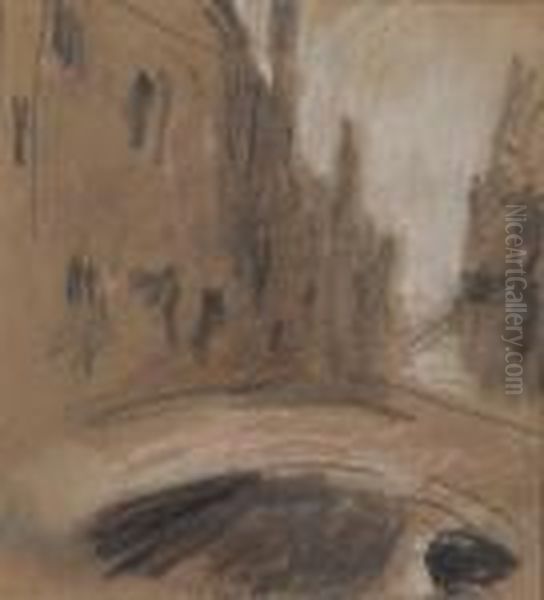
Today, his work is held in major public collections, including Tate Britain in London, the British Museum, and the National Gallery of Ireland in Dublin, among others. His legacy rests on his status as a significant, if initially overlooked, figure in British watercolour painting. He stands as a bridge between the great Romantic tradition of Turner and the advent of Impressionism in Britain, admired for his exquisite colour sense, his evocative handling of atmosphere, and the sheer joy conveyed in his luminous depictions of the world.
Conclusion: A Unique Vision
Hercules Brabazon Brabazon's artistic journey was unconventional. He was an artist of independent means and independent vision, who honed his craft over decades of private practice and extensive travel. When his work finally emerged into public view, it was hailed for its freshness, vibrancy, and modernity. As a master of watercolour, he pushed the medium towards a greater emphasis on colour and light, capturing the essence of place and moment with remarkable skill and sensitivity. Though influenced by masters like Turner and Velázquez, he forged a distinctive style that secured his place as a pioneer of British Impressionism and an artist whose radiant works continue to captivate viewers today.